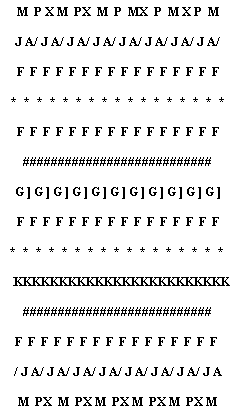 |
Explanatory Notes
Area shown (not to scale) is 10 x 4 meters
Explanation of terms:
M = Castor bean (Portuguese: Mamona)
P = Fodder cactus (Palma)
X = Sesame (Gergelim)
J = Jack bean (Feijão de porco)
A = Pigeon pea (andú)
F = Cowpeas (Feijão)
* = Corn, maize (Milho)
G = Sunflower (Girasol)
/ = Gliricidia (legume fodder tree) seedlings or seeds
# = "cocktail" of vegetables (radishes, peppers, tomatoes, etc.) and legume trees, planted with compost or manure
] = Mulberry seedlings
K = Cassava
Comments:
- With each cactus (P), 2-3 seeds of fruit, fodder and fine hardwoods (to be selected in future) will be planted.
- Spacing:
- Cactus = 1 m in poor soils, 1.5 m in better soils
- Castor bean row - castor bean row = 3.5 - 4 m depending on soils (in better soils, plants are bigger)
- Between rows = 30 cm or less. If the soil is very degrated, plantings should be even denser, adding more rows of jackbean with pigeon peas. Other combinations can be used, according to region and markets.
- Rules of thumb:
- Use legumes (but not vining types) for biomass and nitrogen fixation.
- Include tree element, but must be trees which respond well to pruning.
- Be sure that nothing is taller than the corn. If another plant overshadows it, it should be pruned below the corn height. Most of the other plants here accept light shading from neighbors.
|
![]() No. 48, November/December 2000
No. 48, November/December 2000